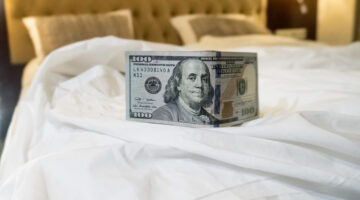Women Reach For Red And Pink Clothes During Ovulation
July 31, 2013 by Justin Lehmiller
Research has found that women attempt to enhance their attractiveness when they are ovulating, a finding that many scientists have argued is an evolved mechanism designed to increase their odds of conception. For example, not only do ovulating women choose to wear more fashionable outfits than women at other stages of the menstrual cycle [1], but ovulating women also experience changes in the pitch of their voice and their body movements that make them more desirable to men [2,3]. A new study published in Psychological Science adds to this growing body of research by suggesting that ovulating women may also choose to adorn themselves with sexier colors as another potential means of enhancing their attractiveness [4].
The basis for this research comes from a series of studies demonstrating that heterosexual men find women wearing the color red to be more attractive than women wearing almost any other color [5]. Why? That’s not entirely clear, but some have speculated that men have evolved a tendency to become aroused by this color because women’s bodies naturally become red/pink during sexual arousal (e.g., many women experience a “sex flush” or reddish rash that appears primarily on the chest during arousal). Strengthening this association between red and sex is the fact that we have been culturally conditioned for years to view women who have painted their faces in reddish tones (e.g., with lipstick and rouge) as being more attractive.
In light of several studies showing that men find women in red sexier, it was theorized that ovulating women would be more likely to report wearing red and/or pink clothes than women at any other stage of the menstrual cycle. In order to test this idea, 100 American women and 24 Canadian women participated in an online survey in which they were asked to report the color of the shirt they were currently wearing and the number of days it had been since their last period, which was used to calculate whether each woman was likely to be ovulating or not [4].
In both groups of women, those who were in the likely ovulation group wore red or pink shirts more frequently than those women who were likely not at peak fertility. Specifically, in the American sample, 40% of the women in the likely ovulation group were wearing red/pink compared to 7% in the unlikely ovulation group (the numbers were 26% vs. 8%, respectively in the Canadian sample). Another way to look at these data is that, across both samples, 76-80% of all women who wearing red/pink were classified as likely to be ovulating.
Several important questions remain about these findings. For example, we know from previous research that women tend to wear “more fashionable” outfits during ovulation [1]. As a result, an alternative interpretation of the findings from the new study is that perhaps ovulating women didn’t chose red/pink outfits specifically because of the color; rather, perhaps clothing manufacturers just tend to make more fashionable outfits in those colors. In other words, we don’t know how the red/pink shirts differed from the shirts in other colors, so it’s possible that color isn’t really the key variable here (maybe this has more to do with fashion than anything). There are also some important methodological limitations. For instance we don’t know with certainty where any of the women were in their menstrual cycle—this was an estimate based upon women’s self-reports and a calculation that assumes all women were on a 28-day cycle. In addition, women who were on hormonal birth control were asked not to participate (given that hormonal birth control is designed to prevent ovulation), but as far as I can tell, the researchers never sought to verify whether any of the women were actually taking birth control, which strikes me as a major oversight.
Although I would like to see these findings replicated in a larger sample that addresses some of these limitations, the results are at least consistent with a large body of research demonstrating that there are noticeable changes in women’s behavior when they are most fertile, and those changes may be reflected in the clothing women select from their closets.
Want to learn more about The Psychology of Human Sexuality? Click here for a complete list of articles or like the Facebook page to get articles delivered to your newsfeed.
[1] Haselton, M.G., Mortezaie, M., Pillsworth, E.G., Bleske-Rechek, A., & Frederick, D.A. (2007) Ovulatory shifts in human female ornamentation: Near ovulation, women dress to impress. Hormones and Behavior, 51, 40-45.
[2] Bryant, G.A., & Haselton, M.G. (2009). Vocal cues of ovulation in human females. Biology Letters, 5(1), 12-15.
[3] Fink, B., Hugill, N., & Lange, B.P. (2012). Women’s body movements are a potential cue to ovulation. Personality and Individual Differences, 53, 759-763.
[4] Beall, A. T., & Tracy, J. L. (in press). Women more likely to wear red or pink at peak fertility. Psychological Science.
[5] Elliot, A.J., & Niesta, D. (2008). Romantic red: Red enhances men’s attraction to women. Journal of Personality and Social Psychology, 95, 1150-1164.
Image Source: iStockphoto.com
You Might Also Like:

Dr. Justin Lehmiller
Founder & Owner of Sex and PsychologyDr. Justin Lehmiller is a social psychologist and Research Fellow at The Kinsey Institute. He runs the Sex and Psychology blog and podcast and is author of the popular book Tell Me What You Want. Dr. Lehmiller is an award-winning educator, and a prolific researcher who has published more than 50 academic works.
Read full bio >


